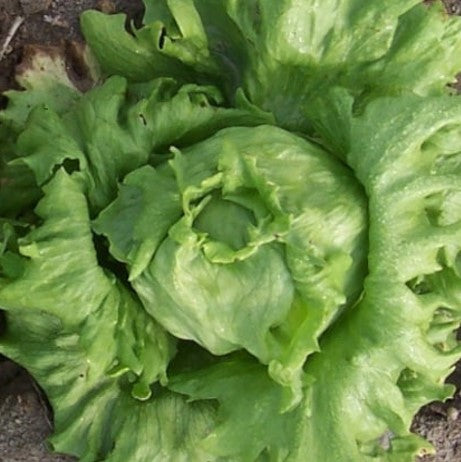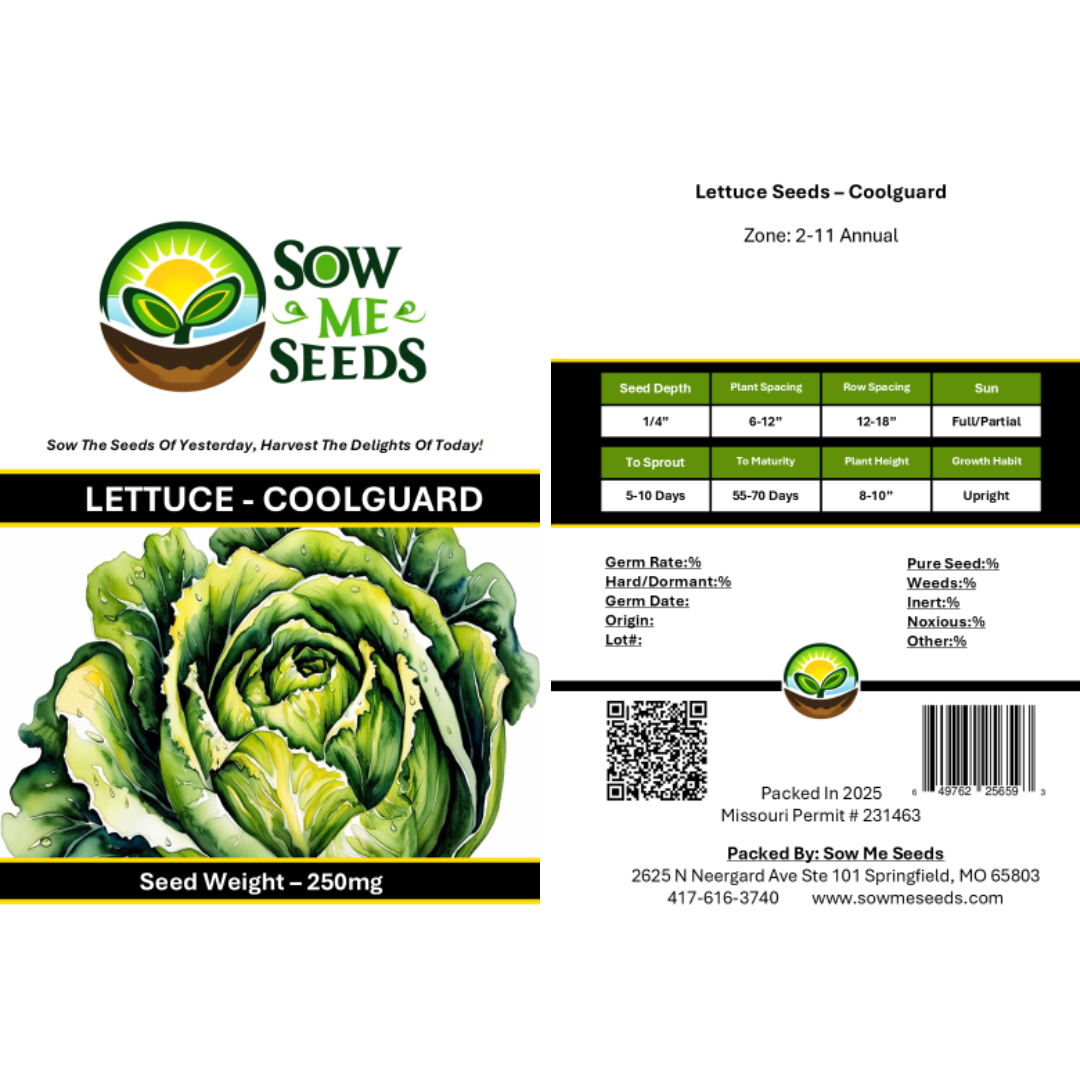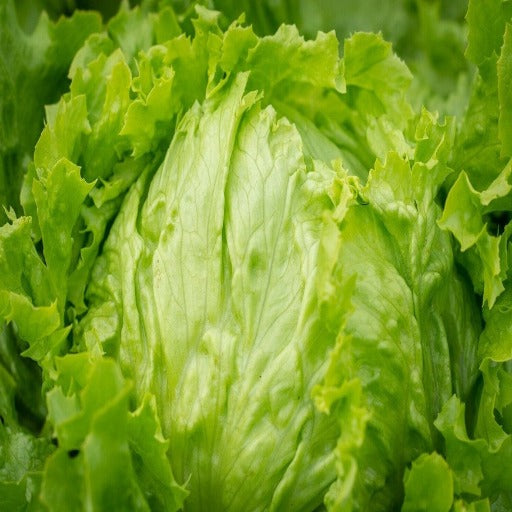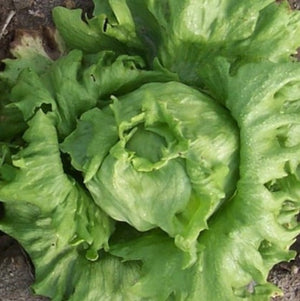- Hardiness Zone: 2-11 Annual
Seed Depth: 1/4 inch
Seed Spacing: 8–12 inches
Row Spacing: 12–18 inches
Sunlight: Full sun to partial shade
Days to Sprout: 7–10 days
Days to Maturity: 55–65 days
Growth Habit: Compact, Upright
Sunlight: Choose a location that receives full sun to partial shade. Lettuce grows best in cooler temperatures and can benefit from some afternoon shade in warmer climates.
Soil: Prefers well-drained, fertile soil with a pH between 6.0 and 7.0. Lettuce thrives in soil rich in organic matter, so amend the soil with compost or well-rotted manure before planting.
When to Plant: Coolguard Lettuce is a cool-season crop that can be planted in early spring or late summer for a fall harvest. In regions with mild winters, it can also be grown throughout the winter. Start seeds indoors 4-6 weeks before the last expected frost date in spring, or sow seeds directly in the garden as soon as the soil can be worked. For a fall crop, sow seeds in late summer or early fall.
Direct Sowing: Sow seeds 1/4 inch deep and 6-12 inches apart in rows spaced 12-18 inches apart. Lettuce seeds are small, so try to space them evenly. Thin seedlings to 6-12 inches apart once they are a few inches tall to allow enough space for the plants to develop.
Transplanting: If starting indoors, transplant seedlings outdoors when they are 3-4 inches tall and the danger of frost has passed. Space plants 6-12 inches apart in rows spaced 12-18 inches apart.
Succession Planting: Sow every 2–3 weeks for a continuous harvest throughout the season.
Watering: Keep the soil consistently moist but not waterlogged. Lettuce has shallow roots and requires regular watering, especially during dry periods, to ensure even moisture. Mulching around the plants can help retain soil moisture and keep the soil cool.
Fertilization: Lettuce benefits from a nutrient-rich soil but does not require heavy fertilization. Apply a balanced fertilizer or compost at planting time. If the leaves appear pale or growth slows, side-dress with compost or a balanced fertilizer.
Mulching and Weeding: Apply a layer of mulch around the plants to retain soil moisture, suppress weeds, and keep the soil temperature consistent. Lettuce is sensitive to heat, and mulch can help keep the soil cool. Hand-pull weeds carefully to avoid disturbing the shallow roots of the lettuce.
Pruning: Remove outer leaves as needed for harvest and to maintain plant health.
Pest and Disease Management: Lettuce can be susceptible to pests such as aphids, slugs, and cutworms. Use organic pest control methods like neem oil, diatomaceous earth, or hand-picking to manage infestations. Practice crop rotation and ensure good air circulation to prevent fungal diseases like downy mildew and leaf spot.
When to Harvest: Coolguard Lettuce is typically ready to harvest 45-55 days after planting. Harvest the outer leaves as needed for a "cut-and-come-again" approach, or wait until the entire head is mature. Lettuce is best harvested in the morning when the leaves are crisp and cool.
How to Harvest: For leaf lettuce, simply cut the outer leaves at the base, leaving the inner leaves to continue growing. For head lettuce, cut the entire plant at the base when the head is firm and mature. Handle the leaves gently to avoid bruising.
Storing Fresh Lettuce: Freshly harvested lettuce can be stored in the refrigerator for up to a week. Wash the leaves and dry them thoroughly before storing in a plastic bag or container with a damp paper towel to retain moisture.
Why You’ll Love It
Heat Tolerant: Specifically bred to resist bolting and tip burn in warm climates.
Crisp Texture: Sturdy leaves with classic romaine crunch — perfect for fresh salads and wraps.
Compact Growth: Uniform heads with strong, upright growth that fit neatly in garden beds.
Extended Harvest Window: Slow to bolt and holds well once mature.
Plant Characteristics
Height: 8–12 inches
Growth Habit: Upright and compact with tightly formed heads
Leaf Type: Medium green romaine-style leaves with a crisp midrib
Days to Maturity: 60–65 days
Hardiness: Cool-season annual
Flavor and Culinary Uses
Flavor: Mild, crisp, and refreshing with a clean finish
Culinary Uses: Perfect for Caesar salads, lettuce wraps, sandwiches, or fresh garden salads
Companion Planting Tips
Good Companions: Carrots, radishes, onions, and beets
Avoid Planting Near: Broccoli and other heavy feeders that may compete for nutrients
Bonus Benefit: Ideal for succession planting — sow every 2–3 weeks for a continuous supply
Common Issues and Solutions
Tip Burn: Provide consistent moisture and partial shade during hot spells
Slugs or Snails: Use barriers or organic bait to prevent leaf damage
Loose Heads: Thin plants early and provide full sun to encourage proper head formation
Seeds Per Packet
| 1g | Approximately 240 |
| 3g | Approximately 720 |
Why You’ll Love It
Heat Tolerant: Specifically bred to resist bolting and tip burn in warm climates.
Crisp Texture: Sturdy leaves with classic romaine crunch — perfect for fresh salads and wraps.
Compact Growth: Uniform heads with strong, upright growth that fit neatly in garden beds.
Extended Harvest Window: Slow to bolt and holds well once mature.
Plant Characteristics
Height: 8–12 inches
Growth Habit: Upright and compact with tightly formed heads
Leaf Type: Medium green romaine-style leaves with a crisp midrib
Days to Maturity: 60–65 days
Hardiness: Cool-season annual
Flavor and Culinary Uses
Flavor: Mild, crisp, and refreshing with a clean finish
Culinary Uses: Perfect for Caesar salads, lettuce wraps, sandwiches, or fresh garden salads
Companion Planting Tips
Good Companions: Carrots, radishes, onions, and beets
Avoid Planting Near: Broccoli and other heavy feeders that may compete for nutrients
Bonus Benefit: Ideal for succession planting — sow every 2–3 weeks for a continuous supply
Common Issues and Solutions
Tip Burn: Provide consistent moisture and partial shade during hot spells
Slugs or Snails: Use barriers or organic bait to prevent leaf damage
Loose Heads: Thin plants early and provide full sun to encourage proper head formation
Seeds Per Packet
| 1g | Approximately 240 |
| 3g | Approximately 720 |





Share and get 15% off!
Simply share this product on one of the following social networks and you will unlock 15% off!